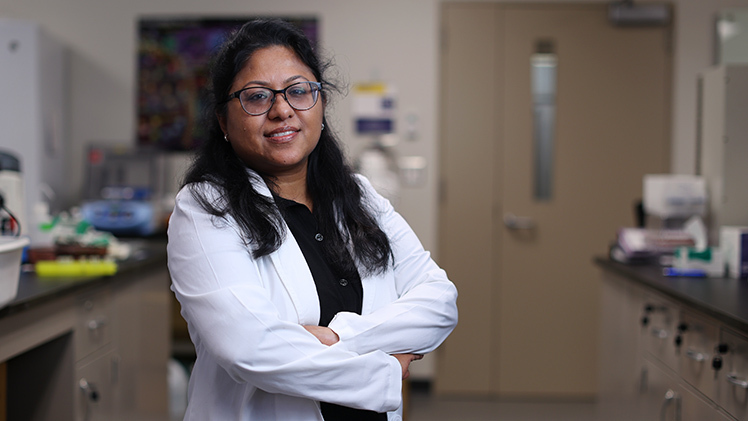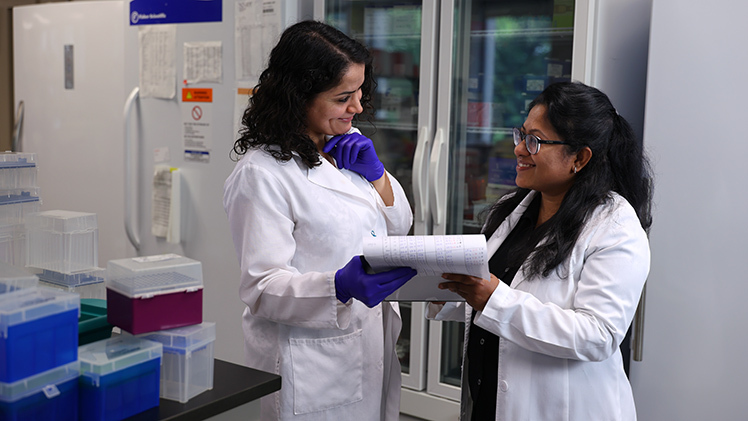New research from The University of Toledo suggests that individuals with anemia may have a significantly higher risk for developing severe complications if they contract malaria.
The findings were published this month in the peer-reviewed journal Infection and Immunity.

A new study led by Dr. Piu Saha, an assistant professor in the College of Medicine and Life Sciences, shows how anemia may help malaria proliferate and offers new ideas for treating the mosquito-borne disease.
While local transmission of malaria is uncommon in the United States, the mosquito-borne disease is endemic to 83 countries worldwide, resulting in hundreds of millions of infections annually.
“We know that malaria can cause anemia. But whether preexisting anemia can aggravate the disease, that part was unknown,” said Dr. Piu Saha, an assistant professor in the College of Medicine and Life Sciences and lead author of the new paper. “Our study suggests not only that it can, but we have also identified potential new ways of fighting malaria, especially in people who are already anemic.”
Malaria is caused by a parasite that attacks red blood cells. Common symptoms of malaria include fever, chills, fatigue and headaches. In more severe cases, it can damage the kidneys and liver, cause breathing problems and even lead to coma or death.
The World Health Organization estimates nearly 600,000 people died from the disease in 2023.
In anemia, there aren’t enough healthy red blood cells to supplying oxygen throughout the body. A variety of things can cause someone to become anemic, including blood loss, malnutrition, autoimmune disorders and a number of chronic diseases.
To understand the relationship between preexisting anemia and malaria, UToledo researchers studied the mosquito-borne disease in mice exhibiting two different types of anemia — one resulting from blood loss, the other from the breakdown of red blood cells.
In her study, Saha found mice with pre-existing anemia had much higher levels of parasites in their blood when infected with malaria, and they lost more body weight and showed more signs of liver damage and inflammation compared to non-anemic mice.
As in humans, anemia in mice spurs the body to produce more red blood cells.
However, some of those red blood cells are released into circulation when they are still immature. Those cells, also called reticulocytes, are a favored target for certain types of malaria parasites, which Saha said is likely why malaria was able to spread more rapidly in anemic individuals.
But that characteristic also gave researchers a potential target for treatment.
“During anemia, there is pressure on the bone marrow to make more red blood cells, which results in more circulating reticulocytes than we would see in healthy individuals,” Saha said. “If having a lot of reticulocytes made it easier for malaria to grow, it made sense to see if reducing the number of those cells could improve malaria symptoms.”

Dr. Sareh Zeydabadinejad, left, a research associate in the Department of Physiology and Pharmacology, was co-author of the paper along with Dr. Saha.
Researchers did that in two ways. First, they gave anemic mice blood transfusions from healthy mice. Secondly, they treated the mice with a monoclonal antibody that targets a receptor found on reticulocytes — but not mature red blood cells.
Both methods lowered parasite levels in mice with malaria and improved the animals’ overall health.
Some patients with severe malaria are already treated with blood transfusions, though the practice is aimed at treating the associated anemia, not necessarily the malaria itself. It’s possible, Saha said, that additional research could show blood transfusions are a valid first-line treatment for malaria, rather than an intervention reserved for very sick people suffering from malaria-induced anemia.
The antibody treatment may hold even more promise. Not only was it more effective at improving malaria symptoms, but it also worked on both anemic and non-anemic mice.
The specific antibody UToledo researchers used has not previously been deployed as a malaria treatment, but it is being widely studied as part of targeted cancer therapies.
While more research is needed, including studies of additional varieties of malaria parasites, the findings could have significant implications.
“There is a great deal of overlap in countries where there is endemic malaria and a high percentage of the population with nutritional deficiencies and preexisting anemia,” Saha said. “That may be making individuals in those regions more susceptible to serious illness from malaria. But more importantly, our research shows treatments targeting reticulocytes might be a novel way of fighting against malaria, which remains a significant threat to human health.”